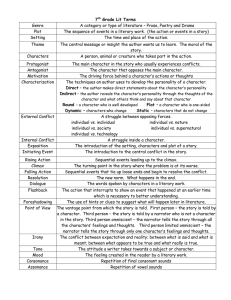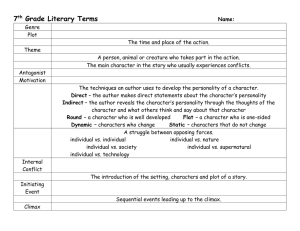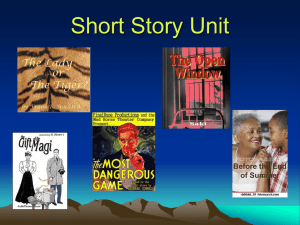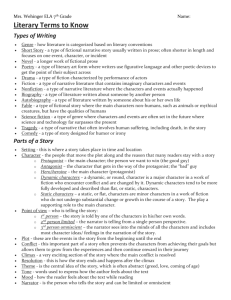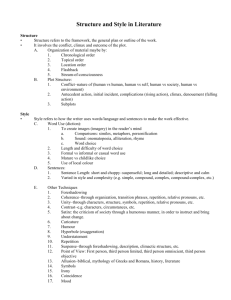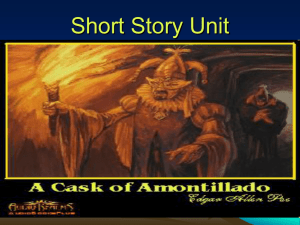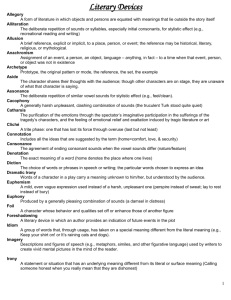literary terms - Woodcliff Lake
advertisement
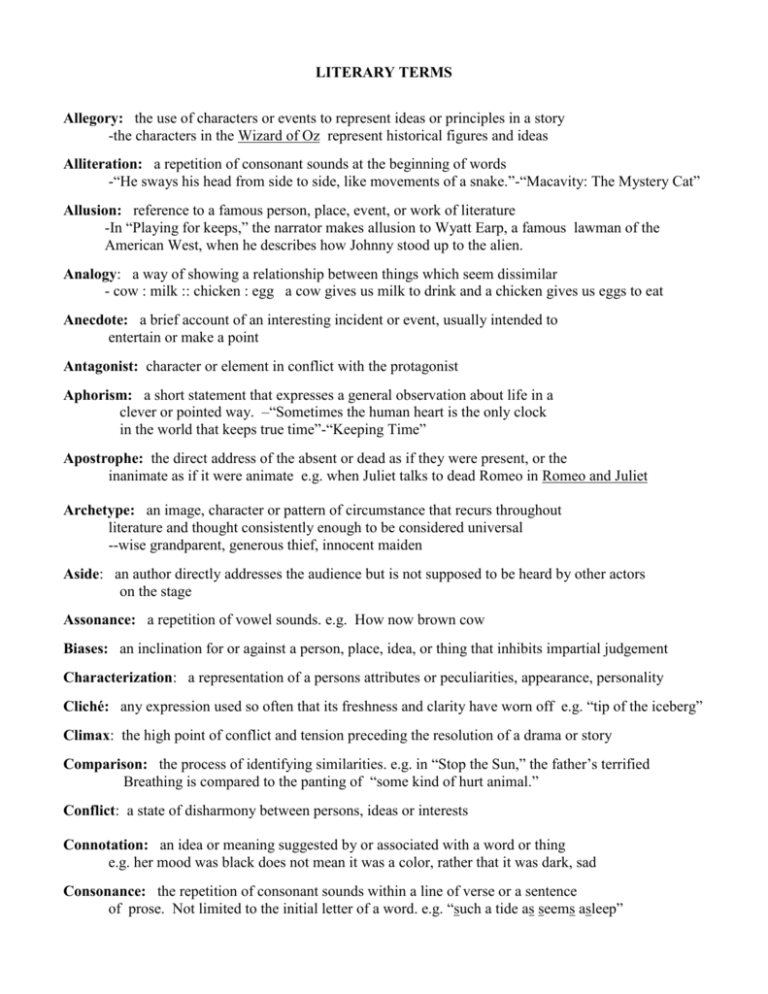
LITERARY TERMS Allegory: the use of characters or events to represent ideas or principles in a story -the characters in the Wizard of Oz represent historical figures and ideas Alliteration: a repetition of consonant sounds at the beginning of words -“He sways his head from side to side, like movements of a snake.”-“Macavity: The Mystery Cat” Allusion: reference to a famous person, place, event, or work of literature -In “Playing for keeps,” the narrator makes allusion to Wyatt Earp, a famous lawman of the American West, when he describes how Johnny stood up to the alien. Analogy: a way of showing a relationship between things which seem dissimilar - cow : milk :: chicken : egg a cow gives us milk to drink and a chicken gives us eggs to eat Anecdote: a brief account of an interesting incident or event, usually intended to entertain or make a point Antagonist: character or element in conflict with the protagonist Aphorism: a short statement that expresses a general observation about life in a clever or pointed way. –“Sometimes the human heart is the only clock in the world that keeps true time”-“Keeping Time” Apostrophe: the direct address of the absent or dead as if they were present, or the inanimate as if it were animate e.g. when Juliet talks to dead Romeo in Romeo and Juliet Archetype: an image, character or pattern of circumstance that recurs throughout literature and thought consistently enough to be considered universal --wise grandparent, generous thief, innocent maiden Aside: an author directly addresses the audience but is not supposed to be heard by other actors on the stage Assonance: a repetition of vowel sounds. e.g. How now brown cow Biases: an inclination for or against a person, place, idea, or thing that inhibits impartial judgement Characterization: a representation of a persons attributes or peculiarities, appearance, personality Cliché: any expression used so often that its freshness and clarity have worn off e.g. “tip of the iceberg” Climax: the high point of conflict and tension preceding the resolution of a drama or story Comparison: the process of identifying similarities. e.g. in “Stop the Sun,” the father’s terrified Breathing is compared to the panting of “some kind of hurt animal.” Conflict: a state of disharmony between persons, ideas or interests Connotation: an idea or meaning suggested by or associated with a word or thing e.g. her mood was black does not mean it was a color, rather that it was dark, sad Consonance: the repetition of consonant sounds within a line of verse or a sentence of prose. Not limited to the initial letter of a word. e.g. “such a tide as seems asleep” Contrast: the process of pointing out differences between things e.g. “Some foster kids come with lots of stuff, but she came with everything she had in a paper bag.”-“Dancer” Conventions: widely accepted rules for grammar, spelling, capitalization, Punctuation Denouement: the final outcome or resolution of a play or story Denotation: the most specific or direct meaning of a word-a word’s definition Dialect: a form of language that is spoken in a particular place by a particular group of people e.g. some of the dialogue in “All things Bright and Beautiful” features the dialect of Yorkshire, England. Dialogue: the words that characters speak in a piece of literature Diction: an author’s choice of words for a particular purpose Dynamic Character: a character who undergoes adaptation, change, or growth--Pinocchio Exaggeration: to represent as greater than is actually the case; overstate Falling Action: what happens in a play or story after the climax. The resolution (denouement) follows Figurative Language: a word or words that are inaccurate literally but that describe by calling to mind sensations that the thing described evokes --antithesis, apostrophe, hyperbole, irony, metaphor, oxymoron, paradox, personification, pun, simile, and understatement Flashback: an interruption of the action to present events that took place at an earlier Time e.g. In “The Bet,” a flashback is used to present the banker’s recollection of a party he gave 15 years earlier. Flat Character: a character who is simple, two dimensional, and shallow. Readers do not feel like they get to KNOW a flat character. e.g. the mother in Little Red Riding Hood Foil: someone who serves as a contrast or challenge to another character --the ugly step sisters in Cinderella make Cinderella even more beautiful Foreshadowing: when a writer provides hints that suggest future events in a story- In many popular movies we know a girl is pregnant long before it is announced by sickness, tiredness etc. Genres: a distinctive category of literary composition, examples include, mystery, adventure, sci fi Hyperbole: an exaggeration for the sake of emphasis that is not supposed to be taken seriously e.g. starving to death, a million times a day Idioms: a phrase/expression with a meaning different from the literal meaning Imagery: words and phrases that appeal to readers five senses e.g. “She smells like the forest floor, like crushed moss and damp leaves, and she is as warm as a radiator..”-“Appetizer” Irony: a contrast between what is expected and what actually exists or happens - In “The Lie,” it is ironic that Dr. Remenzel, after lecturing Eli about not expecting special treatment, himself asks for Eli to be treated specially. Jargon: specialized language of a trade, profession, or group Litotes: a form of understatement that is achieved by saying the opposite of what you mean e.g. calling a fat child skinny or a slow one speedy Metaphor: a comparison between two things that have something in common without using like, as or resembles the dog had “a stick of a leg”-“Moco Limping” Meter: the more or less regular pattern of accented and unaccented syllables in poetry Mood: a feeling that a literary work conveys to the reader -in “The Clown,” mood is light hearted & fun Motif: recurring images, words, objects, phrases, or actions that tend to unify a work of literature e.g. dreams in Romeo and Juliet Onomatopoeia: the formation or use of words such as buzz that imitate the sounds associated with the objects or actions they refer to. -moo, drip, clang, choo choo Organization: Writing that has an inviting lead, purposeful sequencing and no dream ending Outlining: a general description covering the main points of a subject with headings & subheadings Oxymoron: the juxtaposition of contradictory terms e.g. deafening silence Parallel Structure: the repeating of phrases and sentences that are syntactically similar Paradox: a statement that seems to be self-contradictory but, in fact, is true e.g. “The coach considered this a good loss” Paraphrase: a restatement of a passage to make it clearer Personification: the giving of human qualities to an animal or object e.g. In “the Hurricane,” the storm is personified as an “agile dancer” that whirls “on the tip of its toes.” Plot: the outline or plan of action of a story: characters, setting, rising action, climax, falling action, denouement Poetic License: a poet or other professional writer is allowed to break conventional rules of grammar, spelling, form, or citation to make rhyme or meter or general effect better --Dr. Seuss Point of View: the perspective from which a story is told - first person -the narrator is in the story using pronouns such as I, me, we “The Splendid Outcast” - third person- the narrator is not in the story and used pronouns such as he, she, it “The Banana Tree” - omniscient- all seeing Propaganda: one sided persuasion, materials spread abroad by advocates of a doctrine Protagonist: the main character in a story Pun: a word or phrase that is used to suggest more than one possible meaning Resolution: the part of a literary work in which the plot is resolved or simplified Rhetorical Question: a question asked for effect which neither requires a reply nor wants a reply --when it is past bed time and a parent asks, “Isn’t it past your bed time?” Rhetorical Techniques: the tools used in effective or persuasive language --contrast, repetition, paradox, understatement, sarcasm, and rhetorical questions Rising Action: the part of a drama that follows the event that gives rise to the conflict & precedes the climax Rhyme: repetition of sounds at the end of words e.g. “I do not like green eggs and ham. I do not like them Sam I am.” Satire: a literary work that criticizes human vices and folly with ridicule, scorn; wit, irony or sarcasm Setting: the place and time that a literary or dramatic work takes place Sentence Fluency: sentences have varied length and beginnings, they are easy to read aloud Simile: a comparison of two things that have some quality in common, it will include like, as or resembles e.g.“The Ginko is as leathery as an old bull”-“Willow and Ginko” Slang: non-standard vocabulary, figures of speech marked by spontaneity and raciness Stereotypes: an oversimplified, opinion, conception or belief Static Character: a character who undergoes no change e.g. Atticus in To Kill a Mockingbird Suspense: anxiety, excitement or apprehension resulting form an uncertain, undecided, or mysterious situation Symbolism: a person, place, object, or action that stands for something beyond itself -a rose as a symbol of love, white showing purity, black evil or death Syntax: the arrangement – the ordering, grouping, placement – of words within a sentence and sentences within a paragraph Theme: a message about life or human nature that is communicated by a literary Work e.g. in “The Lie” one theme is that lying brings more trouble than the truth Tone: expresses the writers attitude towards his or her subject -in “The Appetizer,” the tone is humorous Voice: an author or narrator’s distinctive style or manner of expression, it can reveal much about the personality of the author or narrator- to make you feel something Word Choice: vivid images created with just the right words and phrases
